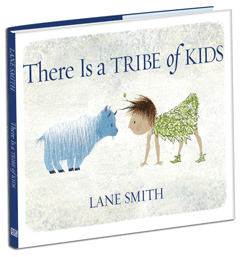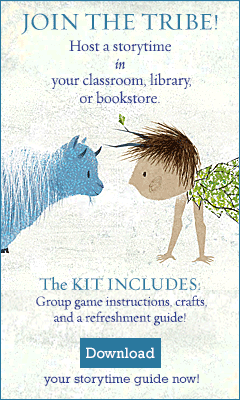There Is a Tribe of Kids
by Lane Smith
Two-time Caldecott Honor artist Lane Smith (The Stinky Cheese Man; Grandpa Green) has created a whole universe within the covers of There Is a Tribe of Kids--a playful, profoundly beautiful universe in which everyone wants to find a home.
The story--a boy's solo odyssey through the natural world--begins with his happy discovery of some baby goats: "There was a TRIBE of KIDS," says the only line of text on this spread... rather insistently, given all those capital letters. Some of the narrative unfurls in wordless comic strip-style panels, such as in the opening scene where, in an expressive triptych 1) the boy hugs one of four goats 2) the goats climb the precipice behind him and 3) the last goat has disappeared out of the picture completely, leaving the boy to gaze forlornly up at their trail from below. These wordless frames are the heart of this lovely picture book, and they often express the joy of interaction between the boy and his new animal friends, followed by a quiet sense of loneliness when they part ways.
Smith's appealing and kid-friendly--yet artfully stylized and elegantly hip--artwork blossoms more and more with each reading. The medium is described as "painted in oils and sprayed with an acrylic varnish to create various mottled textures," with colored pencils, graphite and both traditional and digital cut-and-paste techniques. That sounds like a labor of love, maybe a gloriously messy one, and the snowy texture and depth of it translate gorgeously to the page.
Just as the boy is leaving the sadly goat-less precipice, he spots a penguin. Turn the page and the boy is skating merrily on ice with four penguins, then hugging all of them at once (he's a hugger!), then pretending he has wings to flap. Until--oops--the penguins drop through the ice crack into the water below, followed by the boy: "There was a COLONY of PENGUINS." Here, one begins to wonder if the book will be a series of collective nouns, and will be tempted to peek... YES!
The boy is swimming underwater with "a SMACK of JELLYFISH" in the next spread. It's spectacular! In three vertical panels, the boy's leafy garment billows up when the jellyfish hoods billow up, then closes around him when their hoods close, then his cape floats all the way off his body. (It's okay, he's wearing leafy underpants as well.) Suddenly, a big blue whale swims right up under him, and the boy is sitting on her head. A whole "pod" of whales appears. The boy, now above water on the whale's head, looks quite pleased with his lofty captain's perch until the blowhole sprays, and he turns his head toward the reader as if to say, "Look what I have to put up with."
The boy is quickly scooped up by a raven, which he seems pretty happy about because he gets to fly in the sky with a whole "unkindness" of them. He's less happy when he's accidentally dropped on a "formation" of rocks. Is there anything that doesn't happen in this book? The boy even joins an elephant parade, mimicking their big ears with leaves, and plays two hollowed-out coconut shells with a "band" of gorillas.
In one of the most endearing animal encounters of all, the boy sits against a tree with a caterpillar on his knee. Boy and bug are eye to eye. Then, in 18 postage stamp-sized frames, the boy imitates the changing shapes of the cute-faced caterpillar, involving some entertaining contortions on the part of the boy vertebrate. The boy hangs upside down from a branch with all the other chrysalises, contentedly: "There was an ARMY of CATERPILLARS."
On the next page, an astonishing "flight" of butterflies has hatched, the sun is sinking, the sky golden. When the boy heads for the ocean and night falls upon the seashore, there's a "sprinkle" of lightning bugs and a "family" of stars, a "bed" of clams and a "night" of dreams. Does the boy dream it, or is there really a "trail" of shells that leads to... a "tribe" of kids? Human kids! The tribe of kids, frolicking in and around a giant tree, looks like Peter Pan's Lost Boys, except there are girls, and everyone is dressed in eclectic leaf garments similar to the boy hero's. Is it a homecoming for the boy... or a discovery? Either scenario is cause for giddiness, along with some clever pantomiming of the boy's adventures and more hugs, too.
How to sum up such an original book? Perhaps it's about the deep need for connection--a need shared by humans and animals alike--and the exuberance, and often humor, that arise from that interaction. It's a celebration of the splendid, wondrous natural world where whales spout and caterpillars morph into butterflies, and it's about how sometimes the line between jellyfish and humans, elephants and humans, or gorillas and humans isn't as defined as one might think. --Karin Snelson, children's & YA editor, Shelf Awareness







.jpg) Some of the collective nouns in the book seem "real" and some seem made up.
Some of the collective nouns in the book seem "real" and some seem made up. .jpg) Tell us about the leafy garments of the boy hero. Was that to show he is very much part of nature and not separate from it?
Tell us about the leafy garments of the boy hero. Was that to show he is very much part of nature and not separate from it?.jpg) This is the kind of book where you see a new detail every time you look through it--for example, how the spreads connect even after a page turn, like the penguin in the jellyfish scene, or the spouting whale in the raven scene. Does this all happen at the storyboard stage?
This is the kind of book where you see a new detail every time you look through it--for example, how the spreads connect even after a page turn, like the penguin in the jellyfish scene, or the spouting whale in the raven scene. Does this all happen at the storyboard stage?